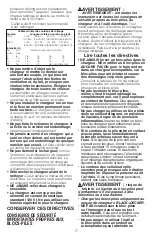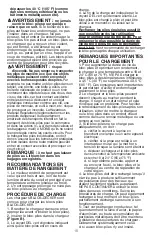
clothing or jewelry. Keep your hair,
clothing and gloves away from
moving parts.
Loose clothes, jewelry
or long hair can be caught in moving
parts.
g)
If devices are provided for the
connection of dust extraction and
collection facilities, ensure these
are connected and properly used.
Use of dust collection can reduce
dust-related hazards.
4)
POWER TOOL USE AND CARE
a)
Do not force the power tool. Use
the correct power tool for your
application.
The correct power tool
will do the job better and safer at the
rate for which it was designed.
b)
Do not use the power tool if the
switch does not turn it on and
off.
Any power tool that cannot
be controlled with the switch is
dangerous and must be repaired
.
c)
Disconnect the plug from the power
source and/or the battery pack from
the power tool before making any
adjustments, changing accessories,
or storing power tools.
Such
preventive safety measures reduce
the risk of starting the power tool
accidentally.
d)
Store idle power tools out of the reach
of children and do not allow persons
unfamiliar with the power tool or
these instructions to operate the
power tool.
Power tools are dangerous
in the hands of untrained users.
e)
Maintain power tools. Check for
misalignment or binding of moving
parts, breakage of parts and any
other condition that may affect the
power tool’s operation. If damaged,
have the power tool repaired before
use.
Many accidents are caused by
poorly maintained power tools.
f)
Keep cutting tools sharp and clean.
Properly maintained cutting tools with
sharp cutting edges are less likely to
bind and are easier to control.
g)
Use the power tool, accessories
and tool bits, etc. in accordance
with these instructions, taking into
account the working conditions and
the work to be performed.
Use of
the power tool for operations different
from those intended could result in a
hazardous situation.
5) BATTERY TOOL USE AND CARE
a) Recharge only with the charger
specified by the manufacturer.
A
charger that is suitable for one type of
battery pack may create a risk of fire
when used with another battery pack.
b) Use power tools only with
specifically designated battery
packs.
Use of any other battery packs
may create a risk of injury and fire.
c) When battery pack is not in use,
keep it away from other metal
objects like paper clips, coins, keys,
nails, screws, or other small metal
objects that can make a connection
from one terminal to another.
Shorting the battery terminals together
may cause burns or a fire.
d) Under abusive conditions,
liquid may be ejected from the
battery, avoid contact. If contact
accidentally occurs, flush with
water. If liquid contacts eyes,
additionally seek medical help.
Liquid ejected from the battery may
cause irritation or burns.
6)
SERVICE
a) Have your power tool serviced by a
qualified repair person using only
identical replacement parts.
This will
ensure that the safety of the power
tool is maintained.
SPECIFIC SAFETY RULES
•
Hold power tools by insulated gripping
surfaces when performing an operation
where the sanding pad may contact
hidden wiring or its own cord.
Contact with
a “live” wire will make exposed metal parts
of the tool “live” and shock the operator.
WARNING:
ALWAYS use safety
glasses. Everyday eye glasses are NOT
safety glasses. Also use face or dust
mask if cutting operation is
dusty. ALWAYS WEAR CERTIFIED
SAFETY EQUIPMENT:
•
A
NSI Z87.1 eye protection (CAN/CSA Z94.3)
•
ANSI S12.6 (S3.19) hearing protection
•
NIOSH/OSHA/MSHA respiratory protection
WARNING:
Some dust created by
power sanding, sawing, grinding,
drilling, and other construction activities
contains chemicals known to the State of
California to cause cancer, birth defects
or other reproductive harm. Some
examples of these chemicals are:
• lead from lead-based paints,
• crystalline silica from bricks and cement
and other masonry products, and
• arsenic and chromium from chemically-
treated lumber.
Your risk from these exposures varies, depending on
how often you do this type of work. To reduce your
exposure to these chemicals: work in a well ventilated
area, and work with approved safety equipment, such as
those dust masks that are specially designed to filter out
microscopic particles.
•
Avoid prolonged contact with dust
from power sanding, sawing, grinding,
drilling, and other construction
activities. Wear protective clothing
and wash exposed areas with soap
3




































